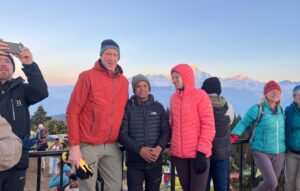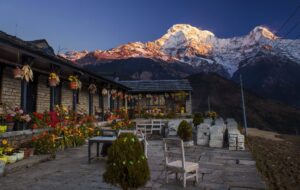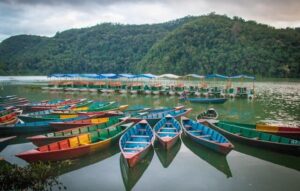Introduction to Annapurna Base Camp Trek
The Annapurna Base Camp (ABC) Trek is one of Nepal’s most iconic trekking routes. It draws thousands of adventure enthusiasts each year due to its breathtaking landscapes, cultural richness, and the thrill of reaching Annapurna Base Camp at 4,130 meters (13,549 feet). While the trek offers extraordinary beauty, it also presents challenges, particularly in terms of altitude, terrain, and weather conditions. As one of the most popular trekking routes in Nepal, understanding the difficulty of the ABC trek is essential for effective preparation, realistic expectations, and a successful trekking experience.
At Kalpa Holidays, we understand that adventure and comfort must go hand in hand, which is why we offer luxury trekking options and personalized itineraries designed to make the ABC trek enjoyable while ensuring safety and preparedness.
Why Annapurna Base Camp is a Must-Do Trek
Nepal’s Annapurna Conservation Area is not just a trekker’s paradise but a protected region boasting rich biodiversity, towering peaks, and warm hospitality from local communities. The Annapurna region is home to Annapurna I, the 10th highest peak in the world, along with Machapuchare, Dhaulagiri, and other iconic Himalayan ranges. Trekkers pass through diverse landscapes, from lush rhododendron forests to terraced fields, before reaching the base camp, which offers stunning views of the Annapurna Massif.
According to Nepal Tourism Statistics 2023, the region saw an increase of 150% in trekkers in 2023, with 154,262 trekkers visiting the Annapurna area. This significant growth highlights the global appeal of the Annapurna Base Camp Trek.
Factors That Make the Annapurna Base Camp Trek Challenging
1. Altitude and Acclimatization Challenges
One of the most critical factors determining the difficulty of the ABC trek is altitude. The trek begins at relatively lower elevations, such as Nayapul (1,070 meters), but rises steeply to 4,130 meters at the base camp. The high altitude means there is less oxygen, which can lead to Altitude Sickness or Acute Mountain Sickness (AMS). Proper acclimatization is crucial to minimize the risks.
In 2023, trekking and mountaineering were among the top reasons tourists visited Nepal, with 154,262 opting for trekking in the Annapurna Conservation Area. The Nepal Tourism Statistics emphasize the need for responsible tourism and acclimatization to ensure safe trekking experiences in these high-altitude areas.
Tips for Acclimatization:
- Ascend gradually, with altitude gains limited to 300-500 meters per day once you pass the 3,000-meter mark.
- Plan rest days at strategic points like Ghorepani or Machapuchare Base Camp.
- Drink at least 3-4 liters of water per day to stay hydrated and aid in acclimatization.
- Be aware of the symptoms of AMS, such as headaches, nausea, dizziness, and fatigue, and descend immediately if they persist.
- Trekkers who manage their acclimatization well can reduce the risk of altitude sickness, ensuring a safer and more enjoyable journey.
2. Terrain and Trail Conditions
The Annapurna Base Camp Trek spans approximately 110 kilometers (68 miles), with trekkers covering 10-15 kilometers per day (6-9 miles), which typically requires 6-8 hours of walking each day. The terrain varies widely, from stone staircases and rocky trails to uneven paths and narrow ridges. The trek is known for its steep ascents and descents, particularly around Ulleri, which has over 3,300 stone steps leading to Ghorepani.
While the trails are generally well-marked, the sheer length of daily trekking combined with the altitude can make the distance feel significantly more challenging. The Nepal Tourism Statistics 2023 report that trekking in the Annapurna Region saw a significant rise in popularity, accounting for 154,262 trekkers in 2023 alone. This surge in numbers highlights the need for careful preparation and physical readiness to navigate the demanding terrain.
At Kalpa Holidays, we recommend trekking with experienced local guides who can assist with pace, navigation, and ensuring a safe and enjoyable experience.
3. Physical Fitness Requirements
The ABC trek, while not as demanding as the Everest Base Camp Trek, still requires a high level of physical fitness. The trek involves continuous hiking at high altitudes, and the variable terrain can be physically taxing. Trekking through steep ascents and descents requires strong leg muscles, endurance, and stamina.
Before embarking on the ABC trek, it is essential to prepare your body for the rigors of trekking. We recommend beginning a training program at least 3-4 months in advance, focusing on:
- Cardiovascular endurance through running, cycling, or swimming.
- Strength training to improve leg, core, and upper body strength, especially for carrying a backpack and tackling steep climbs.
- Hiking on varied terrains while carrying a weighted backpack to simulate the conditions you’ll face during the trek.
The Nepal Tourism Statistics 2023 note that the Annapurna region attracts trekkers of all ages, particularly those in the 31-45 age group, which accounted for 31% of the total trekkers. Preparing physically will allow you to fully enjoy the stunning scenery and rich culture along the way without being overwhelmed by fatigue or injury.
4. Weather Conditions and Seasonal Variability
Weather is a critical factor in determining the difficulty of the Annapurna Base Camp Trek. The best trekking seasons are spring (March-May) and autumn (September-November), when the weather is more stable, visibility is clear, and temperatures are moderate. These months see the highest number of visitors, with Nepal Tourism Statistics reporting peak arrivals in October.
However, even in favorable months, the weather can be unpredictable at higher altitudes. Cold temperatures, rain showers, and even snow can make trekking difficult. In addition, the temperature at Annapurna Base Camp can drop significantly at night, even during the warmer months.
To manage these conditions, trekkers should:
- Pack layers, including moisture-wicking base layers, insulating mid-layers, and waterproof outer layers.
- Carry high-quality trekking boots to navigate wet or rocky terrain.
- Stay informed by checking weather forecasts before and during the trek.
For those trekking during winter, the Annapurna region sees fewer trekkers but faces more extreme weather, including snow-covered trails and lower temperatures. In 2023, trekking activity in Annapurna dropped significantly during the off-peak months due to harsher weather conditions.
5. Altitude Sickness and Health Risks
Altitude sickness is a real challenge for trekkers reaching altitudes above 3,000 meters. The Annapurna Base Camp Trek involves a rapid ascent to 4,130 meters, which can trigger symptoms of AMS, including headaches, nausea, dizziness, and fatigue. Trekkers should always monitor themselves and their companions for signs of AMS.
Tips for Managing Altitude Sickness:
- Ascend slowly and avoid climbing more than 500 meters per day after reaching 3,000 meters.
- Rest at key acclimatization points like Ghorepani or Machapuchare Base Camp.
- Drink plenty of fluids to stay hydrated and maintain energy levels with carbohydrate-rich foods.
- Descend immediately if AMS symptoms worsen, and seek medical assistance if necessary.
In 2023, there were reports of altitude-related evacuations from the Annapurna region, highlighting the importance of acclimatization. At Kalpa Holidays, we ensure that all our clients are fully briefed on the risks of AMS and the best practices for acclimatization before embarking on the trek.
6. Cost of Trekking and Budget Considerations
While the Annapurna Base Camp Trek is generally considered more affordable than some other treks in Nepal, such as Everest Base Camp, costs can increase significantly at higher altitudes. Food, accommodation, and bottled water become more expensive as they need to be transported by mules or porters in the absence of motorable roads.
The Nepal Tourism Statistics 2023 note that the average daily expenditure per tourist in Nepal increased to $41 per day, which includes meals, accommodations, and other expenses. In the Annapurna region, trekkers should budget for higher prices, particularly in the higher altitude tea houses, where a simple meal could cost three times as much as in lower regions.
For a more comfortable experience, Kalpa Holidays offers luxury trekking packages that include higher-end accommodations, private guides, and personalized services to ensure you trek in comfort.
7. Sustainability and Eco-Friendly Trekking
With the growing number of trekkers in the Annapurna region, there has been increased emphasis on sustainable tourism and eco-friendly practices. The Annapurna Conservation Area Project (ACAP) manages conservation efforts in the region, ensuring that tourism growth does not damage the fragile environment.
Sustainability Tips for Trekkers:
- Bring a reusable water bottle and purification tablets to reduce plastic waste.
- Stick to marked trails to avoid damaging flora and fauna.
- Support local communities by staying in locally-owned tea houses and purchasing locally-made products.
According to Nepal Tourism Statistics 2023, the Annapurna Conservation Area continues to attract trekkers who are increasingly aware of the importance of sustainable tourism. At Kalpa Holidays, we actively promote eco-friendly trekking options and ensure our itineraries align with the principles of responsible tourism.
Conclusion
The Annapurna Base Camp Trek offers a once-in-a-lifetime opportunity to explore one of the world’s most breathtaking trekking regions. While it presents certain physical and logistical challenges, the rewards far outweigh the difficulties. With proper preparation, acclimatization, and guidance, trekkers of all levels can successfully complete this iconic trek.
Whether you’re a seasoned trekker or a first-time adventurer, Kalpa Holidays provides customized itineraries that ensure your ABC trek is not only safe and comfortable but also filled with unforgettable memories. As the Annapurna region continues to grow in popularity, now is the perfect time to embark on this remarkable journey.
Let Kalpa Holidays guide you to new heights and make your Annapurna Base Camp trek an experience of a lifetime!







0 Comments